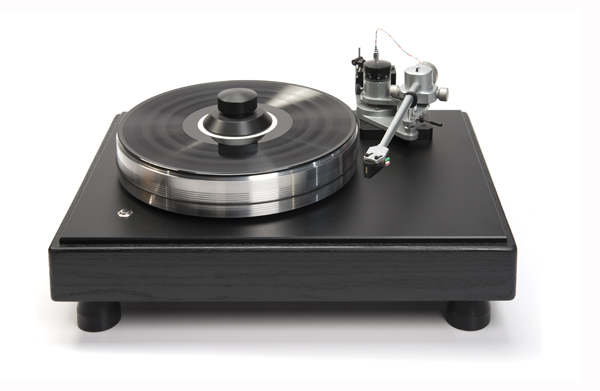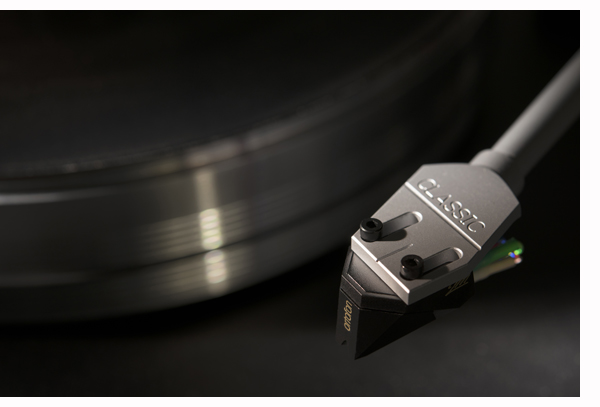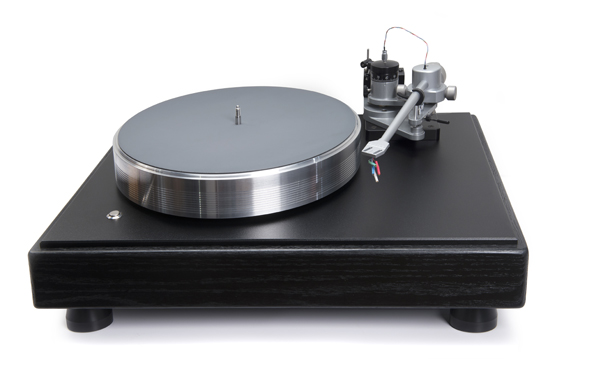 In audio, like in so many other things, the seed of a great idea often sprouts before the technology of the time is able to fully express the concept. The direct-drive turntable is a perfect example. Many know of the legendary Technics SP-10 broadcast turntable, though few have heard one. Those who have will remember the remarkable pitch stability and the rock-solid bass. Today, they are coveted and being rebuilt around modern tonearms and cartridges possessing much more resolution than what was available back in the 1970s and ’80s, and to good result. However, the cost is high and there are a finite number of spare parts—not to mention precious little support. Great as the SP-10 is, owning one today is much like owning a vintage sports car: It’s a ton of fun on a sunny Sunday afternoon, but God forbid you need it repaired in a hurry.
In audio, like in so many other things, the seed of a great idea often sprouts before the technology of the time is able to fully express the concept. The direct-drive turntable is a perfect example. Many know of the legendary Technics SP-10 broadcast turntable, though few have heard one. Those who have will remember the remarkable pitch stability and the rock-solid bass. Today, they are coveted and being rebuilt around modern tonearms and cartridges possessing much more resolution than what was available back in the 1970s and ’80s, and to good result. However, the cost is high and there are a finite number of spare parts—not to mention precious little support. Great as the SP-10 is, owning one today is much like owning a vintage sports car: It’s a ton of fun on a sunny Sunday afternoon, but God forbid you need it repaired in a hurry.
Enter Harry Weisfeld
A visit to the VPI factory in New Jersey with company founder Harry Weisfeld reveals a massive collection of turntables. Weisfeld is particularly well versed in direct-drive models, especially the classics. His collection includes, among others, the Denon DP-80 and JVC TT-101, as well as other Technics tables. “I believe direct drive is the way to go when it’s done correctly,” he says. “I’ve always been a huge fan of the concept, but you can’t get a belt or a pulley perfect, no matter how hard you try. A belt-drive turntable consists of multiple mistakes and you’re always dealing with multiple tolerance errors. Direct drive eliminates these issues.”
Discussing the cost of the new Classic Direct, which is priced at $30,000, Weisfeld reflects on the SP-10. Because of the manufacturing complexity required to produce the SP-10, he says that, if new examples were being built today, they would be fairly comparable in price, even from a company like Technics.
Weisfeld says that the Kenwood L-O7D and Micro Seiki DDX-1000 were the impetuses for making his own direct-drive table, a process that began in earnest in early 2011. One of the engineers at a firm that produces finely machined parts for VPI, as well as military hardware, and who is a known audiophile, started a major discussion with Weisfeld about the “toughest part of a turntable to manufacture.”
The engineer quickly responded that the motor was the toughest challenge, which led to another series of discussions resulting in the design we see here in the Classic Direct, where the platter is actually the main component in the motor. In this case, the motor in the Classic Direct is an AC motor, which Weisfeld prefers over DC motors. He smiles and says, “An AC motor knows where it is, and a DC motor only knows where it was.”
The secret here is that a three-phase motor is used, eliminating the cogging effect that always plagues direct-drive designs. This uneven power delivery results in a slight unsteadiness to the music at worst and a shrinking soundstage at best. These issues are a thing of the past with the Classic Direct, as my listening quickly reveals.
Fortunately for Weisfeld, building the first Classic Direct was a labor of love for the engineers involved—it was strictly a fun project. Reflecting on the nature of the company building the motor, Weisfeld laughs and says, “The reason I won’t tell you who makes the motor for us is not a security reason; they just don’t want to become a supplier for other manufacturers.” He then proceeds to show me all of the measurement data that went into the design, from prototype to final product. “These guys measure everything, and they are thorough.” Case in point: Noise level on the Classic Direct is lower than minus 100 dB—impressive.

Blacker than Black
Initial playback of the Classic Direct at the New York Audio Show this past May was exciting, but the prototype, made using a Classic 3 chassis, didn’t really work aesthetically with the 12-inch tonearm, which Weisfeld felt was essential to the ultimate sound of the table. “So we had to do one more round of plinth design,” he says. “But the drive system was final at this time.”
The proof is in the listening. Forget all the audiophile clichés about inky-black backgrounds. The Classic Direct has a complete absence of background; it’s eerily quiet, like listening to a high-resolution digital file with the life of analog. We start our listening sessions with some vintage classical test pressings from the Classic label, and I’m immediately transfixed. There’s something dramatically different here.
Music simply emerges from the dimly lit room through Weisfeld’s reference speakers, the JBL DD6600 Everests. With dynamic range like few others, the Everests highlight the Classic Direct’s ability to remove itself from the equation and pass the music from the record groove through the speakers without interruption. The Everests sound surprisingly coherent, more like a pair of electrostatic speakers (of which Weisfeld and I are both big fans). I am spellbound by how natural pianos and violins sound in this system.
I’m so taken aback by the cleanliness of the tone that I don’t notice the cartridge mounted to the 12-inch 3D-printed tonearm, which is standard issue with the Classic Direct. It’s a Shure M97, the same one you can buy from Music Direct for $100. Weisfeld smiles again. “It’s my daily driver,” he says. “When I mounted a JICO stylus on the M97, it changed the sound completely, and it tracks like crazy. It saves wear and tear on my Lyra Atlas.”
Fortunately, the unipivot design of the VPI tonearms, with removable arm wands, makes it easy to swap cartridges—for vinyl aficionados with multiple cartridges in their collection. An additional 12-inch 3D-arm wand can be purchased for $3,000, while a standard one machined from aluminum is only $1,500—a perfect match for cartridges on the less-spendy side of the equation.
Getting in the Driver’s Seat
Once I’m acquainted with the Classic Direct, Weisfeld swaps the Shure for his favorite (and mine), the Lyra Atlas. But first we listen to Dave Brubeck’s classic track “Take Five” on tape. Quickly switching back to the Analogue Productions 45-rpm version reveals precious little loss, only in the ultimate dynamics of the vinyl not being able to stretch on the quickest transients as fast as the tape, but the soul of the music on the Classic Direct is incredibly well represented. Timbre and tonality are perfectly captured, along with the airiness of the cymbals and the rock-solid character of the piano. Weisfeld has clearly met his design goals in this respect.
Then, once we move back to the beginning of the journey with the M97, the core values of the music are still intact. Timbre and drive are especially compelling, but now after hearing the tape and the Atlas, there is cloudiness to the overall presentation. Regardless, the Shure sounds far more exciting than I’ve ever heard it before and light years beyond what it sounds like on my Technics SL-1200.
Auditioning a string of familiar rock recordings reveals the same things: a larger soundstage, wider dynamic range and a new sense of being able to peer deeply into the music—all of which are now available with the Classic Direct. The triangle in Joni Mitchell’s “Down to You” not only has an incredibly well defined space, but the decay is breathtaking, and it just seems to hang in the air forever. The rest of Court and Spark, though I’ve heard it countless times, infatuates me as if hearing it for the first time again. That’s what makes a high-dollar component special—and the Classic Direct delivers the goods in every aspect.
Led Zeppelin’s “No Quarter” blazes through loud and clear. While the Classic Direct’s speed stability doesn’t reveal itself as much when rendering Jimmy Page’s guitars, it speaks volumes with the sheer attack of John Bonham’s drums. They goes from fantastic to truly explosive, and the rest of this recording goes well beyond speaker boundaries, forming a coherent and convincing musical image.
A quick spin of a 45-rpm maxi single of Prince’s “I Could Never Take the Place of Your Man” reveals the inner detail in this multitracked tune, which I’ve never heard as clearly. And while the Classic Direct’s major strength is tonal purity, its incredibly low noise floor uncloaks treasure in even the most highly processed records. In this case, backing vocals, synthesizer and percussion tracks are all more evident, with their own distinct placement in the soundstage, where they have always seemed somewhat vague. You don’t have to limit your musical taste to acoustic music to really hear what the Classic Direct can bring to your system.
 Two Years in the Making
Two Years in the Making
After a year and a half, the design of the Classic Direct was final and all that remained was sorting out the ultimate form factor. While so many of today’s mega tables feature an excess of bling, the Classic Direct keeps it simple and straightforward. Much like the aesthetic of the Eames Lounge Chair, this table is a classic in the ultimate sense of the word, rendered in a form factor you will not tire of.
The platter of the Classic Direct is the rotor, eliminating any errors resulting from motor-shaft coupling and taking advantage of VPI’s inverted bearing as the common support for the rotor and platter. Simplicity combined with 21st-century technology wins the day—and the tolerance between the platter and the rest of the motor is only .001 inches.
This assembly is a sealed unit that weighs approximately 40 pounds and is in separate packaging from the base, requiring that the user merely connect power and gently slide it in with the supplied handle. As the saying goes, there are no user-serviceable parts inside. Weisfeld tells me that this motor is built to outlast the owner, because “we don’t want to have to fix them.” (The motor, that is.)
Historians of the direct-drive system may be quick to comment that this approach has been tried unsuccessfully before, but this time it succeeds brilliantly, hence the engineering time and resulting cost of this table. VPI’s proprietary coil technology forgoes the standard wire-wound stator found in most motors, using slotted copper laminations instead. This allows for higher coil density, in turn giving the Classic Direct tremendous torque, even for a direct-drive design. Yet, it was designed to start rotating very slowly, another aspect of successful motor control.
VPI’s familiar outer-ring clamp is the final piece to the puzzle, and if you think you can get by without it, guess again. The clamp firmly anchors the outer edge of the record to the supplied mat, making sure it contacts the platter fully, eliminating the need for one of those fancy record flatteners. It also minimizes vertical stylus excursion, thus maximizing the soundstage. The rest of the table is straightforward, with 33- and 45-rpm speeds controlled by blue illuminated buttons on the left side of the plinth.

Worthy of the Name and the Price Tag
Record after record reveals the same thing: The VPI Classic Direct is one of the world’s finest turntables. If there is a flaw in its presentation, I am not able to expose it, no matter what kind of music is played.
Crazy as it might sound to the uninitiated, $20,000 to $30,000 is really the sweet spot for what I consider a “destination turntable.” I’ve spent more than my fair share of time with six-figure tables, and much like a Ferrari, they offer a level of performance unattainable by any other means, but they are just so far out of reach to all but the most affluent audio enthusiasts that it’s not even a consideration. The ratio of $150k turntable owners to $150k system owners is tipped well in favor of the latter, so for a certain breed of audiophile, a $30k table is not out of the question, especially if you are trading up from something else.
And I must confess that my experience with this range is healthy, having lived with tables from AVID, Clearaudio, Kronos, SME and VPI, just to name a few. As much fun as it always is to proclaim something a game-changer, running down the path of adjective excess, I’ll keep my description of the VPI Classic Direct, well, direct.
It’s solid and quiet in a way I’ve never experienced, even compared to the mighty Continuum, the silly Onedof and the massive Clearaudio. If pitch stability is something you crave, there’s just something about a direct-drive turntable, even a Technics SL-1200, that grabs you instantly. The Classic Direct just has much more of it, and it’s mated to a world-class tonearm to complete the package.
The presentation of the Classic Direct is remarkably close to that of a master tape on a great open-reel deck, which Weisfeld just happens to have next to his equipment rack for his own comparisons. He smiles. “This truly was my inspiration for the Classic Direct,” he says. “Now a piano sounds like a piano.”
I have purchased products from all over the world—and have been doing so for most my life—but I have to confess some American pride here. We in the United States now have a manufacturer building a turntable that not only competes with the best tables that the world has to offer but that also excels beyond many of them.
This is why we bestow our overall Product of the Year award to the VPI Classic Direct turntable.
– Jeff Dorgay
VPI Classic Direct Drive Turntable
www.vpiindustries.com





 VPI’s Classic One set the standard for analog performance at its price a few years ago when introduced and one is still in service at TONEAudio as a reference component, recently revised by Harry Weisfeld to accommodate an Eminent Technologies tonearm.
VPI’s Classic One set the standard for analog performance at its price a few years ago when introduced and one is still in service at TONEAudio as a reference component, recently revised by Harry Weisfeld to accommodate an Eminent Technologies tonearm.










